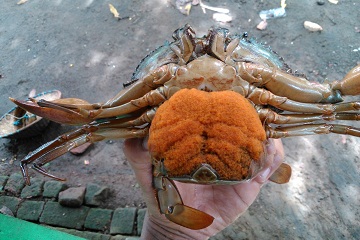Researchers of IPB Inspected the Optimum pH for Mangrove Crab Growth

The abiotic factor (non-living thing) that affected the growth and survival of crab one of them was the level of acidity (pH). The optimum pH media would have the maximum impact on the mangrove crab, as it was associated with the osmoregulation process.
Therefore, four researchers consisting of Yuni Puji Hastuti, Horas Nadeak, and Kurnia Faturrohman from the Department of Aquaculture, Faculty of Fisheries and Marine Science, Bogor Agricultural University (FPIK of IPB), along with Ridwan Affandi from the Department of Water Resource Management, Faculty of Fisheries and Marine Science (FPIK) of IPB, conducted a research to see the effect of pH on the survival rate (SR) and the growth of mangrove crab of Scylla serrata through the physiological condition reaction.
The crabs used were 30 mangrove crabs for each treatment, the density of seeds used were as many as ten in each repetition. The stocked seeds had an average length of 4.45 centimeters, an average width of 6.27 centimeters, and an average weight of 51.27 grams. The crabs were preserved in the fiber box containers measuring 40×60×40 cubic centimeters with the recirculation system.
“The recirculation system used aims to maintain the quality of the maintenance media to remain in the expected condition and to reduce the accumulation of feces and the remaining feed in the container maintenance,” said Yuni.
In the experiments, the researcher gave four different treatments of pH in the test animals. The treatments were with the medium of pH 5 (A), the medium of pH 6 (B), the medium of pH 7 (C), and the medium of pH 8 (D).
Based on the results of the experiments, the research team found that the crab maintenance at different pH had a significant effect on the crab survival rate. The highest survival value was found in the treatment of C (pH 7) that was 83.3 percent and the lowest was in the treatment of D (pH 8) that was zero percent, whereas in the treatments of A and B respectively were 53.3 percent and 53.3 percent.
The pH treatment also gave a significant effect of the specific growth of the crab. The highest specific growth rate was found in the treatment of C that was 10.2 percent per day and the lowest in the treatment of D that was 3.4 percent per day, whereas in the treatments of A and B successively were 7.4 percent per day and 8.1 percent per day.
“The best pH treatment for the production performance which includes the growth parameter and the survival rate of the crab is pH 7. The pH 7 treatment also has the best stress response performance during the maintenance supported by the optimum water quality parameters, the low level of the crab stress at pH 7 is illustrated by the high total hemosit value, so that pH 7 is the optimum condition to support the environmental balance of the crab,” she said. (IRM/ris)



